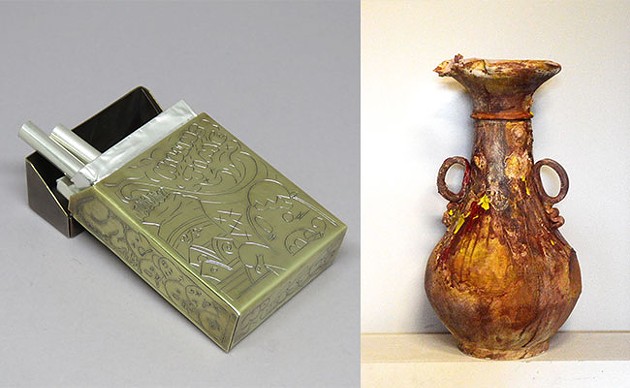Kaashif Ghanie, Adaption and Nicholas Rosin, Disposable Income
To June 24
Hermes, 5682 North Street
In the latest exhibitions at Hermes, curator Becky Walter-Nolan has paired two emerging artists fresh out of the 2018 airCRAFT residency at the Centre for Craft Nova Scotia.
Entering the gallery we see the five large ceramic pots that make up Kaashif Ghanie's Adaptation. The shapes are those of traditional Islamic vessels, but Ghanie has scaled each piece up by at least 10 times its intended size, creating towering works on a more human scale. They are vessels in dual sense—designed to physically hold and contain, but vessel can also refer to a person in whom some quality, like grace, is infused. Ghanie's vessels are empaths, they show pain and healing, and act as vessels for human emotion and experience.
A first-generation Muslim Guyanese Canadian, Ghanie considered stereotypes and his own experiences with Islamophobia and reflected these sentiments in his pots. Under Ghanie's hands the clay takes on corporeal qualities—ceramic becomes sinew, muscle and blistering skin; glaze becomes tears and bile.
In "Ointment" Ghanie reflects on a childhood burn and a doctor's refusal to treat a brown Muslim boy, the surface of the pot bubbling and dripping like a wound. Ghanie explains that to an extent he sees these vessels as people, and like people believe they have the ability to adapt to their environments—scarring, breaking and bleeding, but also the ability to heal and become resilient. In "Armoured" the glaze appears like rusted metal (a nod to the metallic glaze of Alhambra pots). "Time wears many things down but armour allows them to endure," writes Ghanie. In "That One," a reference to times when Ghanie has been "othered," a lattice is cut in the face of the vessel so that negative words can't be contained.
Ghanie's pots are highly emotional creatures, which is fitting when considering that works like "All Eyes on Me" and "Man Up" are based on small vessels that, in the time of the Prophet, were used to hold women's tears. Ghanie explains that traditionally Islamic art forms are sacred, pots like the ones that inspired Ghanie's would have been made in devotion to god. In Adaptation Ghanie seamlessly blends the sacred and the profane, and demonstrates how intrinsically linked beauty and pain can be.
In Disposable Income, Nicholas Rosin's craft objects also take on their own form of animation. A jeweller and engraver, Rosin uses his metalsmithing skills to fabricate small one-to-one sculptures of everyday disposable objects. Condom wrappers, dime bags, twisted straws and Big Mac boxes are all meticulously crafted and engraved with bubble letters, spirals and the kinds of cartoonish figures one would find swaddling graffiti. Despite the throw-away nature of the objects the sculptures represent, Rosin has presented them like fine jewellry, the more intricately carved works such as "Pick Me Up," sitting atop a turntable, allowing the viewer to peek at them from every angle.
Rosin's use of irony is somewhat on the nose. The ideas around consumption could be seen as recycled (pardon the reference)—coffee, drugs, sex and junk food are all vices, vehicles of our contemporary over-consumption, our vices laid out on white plinths and rotating displays. But at the same time, for Rosin it is our relationship to disposability that is our true addiction—it's the packaging for our cigarettes, coffee and food that is still our blind spot.
Rosin's sense of materials and form are the most engaging elements of this work. It's beautifully crafted, and the engraving style—referencing graffiti styles, doodles and street art—as well as his small engraved scenes of cityscapes and streetcorners, are completely charming.

